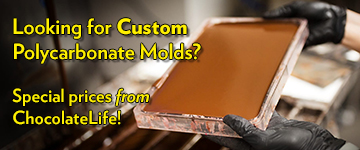Hi James,Let me post a section of an interview that I did for Cocoa Content:
http://www.cocoacontent.com/interview_patric.html My response also includes an interesting quote from life-long chocolate industry insider, the late L. Russell Cook, that may interest you."
CC: Do you age your chocolate, and if so, how much importance do you place in aging?Yes, I do age my chocolate. It is aged in large blocks prior to tempering and molding, and I think that aging definitely does make a positive difference in overall flavor, at least that is what my taste-buds and nose tell me based on aging my own chocolate. Let me quote an interesting passage written by L. Russell Cook from his excellent book Chocolate Production and Use:The deliberate aging of chocolate has for many years been recognized as an important part of the manufacturing process of high quality dark chocolate, in that it develops flavors that can be acquired in no other way. It is true that conching accomplishes some of the purposes of aging, but it cannot substitute for it. Just what scientific explanation could clarify the causes or effects of aging, no one knows. Oxidation and chemical interaction among complex organic compounds of the material we know as chocolate undoubtedly take place, but that is a most unsatisfactory answer to the question of just what occurs. All that we know is that some of the most prized dark chocolates ever made are quite ordinary and, in some cases, almost objectionable when freshly made. Yet, when aged three to six months, these products are truly food of the gods.It is interesting to see that 25-30 years after this passage was written, there really still arent many scientific studies that would explain flavor changes during aging. We understand better that cacao and chocolate absorb oxygen fairly readily, which may allow for the oxidation changes that Cook describes, and it is clearer, according to some authors, what some of the chemical changes possible during storage may be, such as an increase of furans, chemicals responsible for toasty and caramel flavors, and development of sulfur compounds that likely impact the chocolate flavor in a positive way, but these explanations are still rather rudimentary, and since large companies, who have the funds to hire food scientists/technologists, do not age their chocolate, I would be surprised if much more scientific data would be added in the coming years. So, we are left with having to use old-fashioned scientific instruments to tell if aging makes a differenceour noses and mouths. "Let me also add that though Holy Cacao is right about crystal type migration over time, aged chocolate is, in every case that I have heard of, melted down and tempered
after aging, so that the crystals are all destroyed and temper must be restored prior to molding. In other words, aging shouldn't have any impact on texture as it relates to crystal types in these cases. Also, since Beta 6 crystals actually have a higher melting point than Beta 5, if chocolate were to be mostly composed of Beta 6 crystals, it would not melt as readily in the mouth, and would, therefore, lead to a worse mouthfeel.Also, I am one of those chocolate makers who ages my chocolate, and I make no secret of it, and though I guess that anything that is mentioned is marketing in some since, my decision to age the chocolate is not based upon wanting to market it more effectively, but rather upon flavor, and actually, I can tell you that most people absolutely do not pay attention, at least at this point, to the details of chocolate making such as aging, or even conching. 99.99% of the people who eat my chocolate have no clue that I age the chocolate, and even when they do find out, they rarely seem to care particularly. They just care about flavor. That being the case, it it were just marketing, it would be a pretty dumb business decision on my part as it requires me to spend a significant amount of money on cacao and labor prior to busy chocolate sales seasons just to get enough chocolate on the shelves every week to supply my estimated weekly need down the line.Finally, to answer your question from another perspective, I don't think that it is the aging of chocolate that puts it into a league with other products such as cheese, wine, beer, and balsamic. I think that it is the overall complexity of the product in terms of preparation and flavor, including that fact that the cacao from which chocolate is made is both fermented and roasted, a claim that only a handful of other foods can boast. And anyway, fermentation, at the least, is something shared by the other foods mentioned above.Very best,Alan

